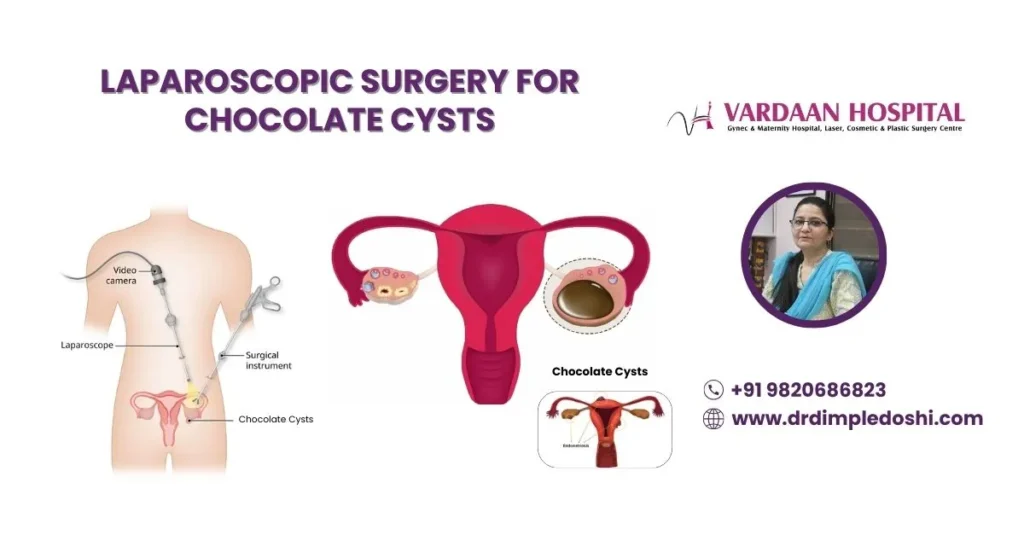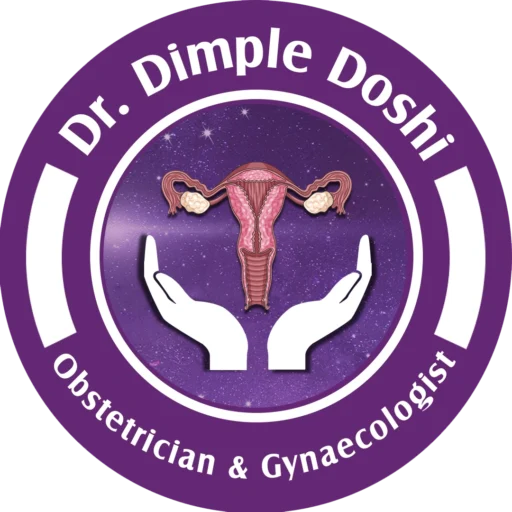Laparoscopic Surgery for Endometriosis & Chocolate Cysts: Procedure, Recovery & Cost in Mumbai

Table of Content
- Understanding Endometriosis & Chocolate Cysts
- What If Endometriosis Is Untreated?
- Why Choose Laparoscopic Surgery?
- How lapraroscopic Treats Endometriosis?
- How lapraroscopic Treats Chocolate Cyst Surgery?
- Types of Laparoscopic Procedures
- Pre-Surgery Preparation
- Post-Surgery Care for Endometriosis
- Recovery Timeline After Surgery
- What to Expect After Surgery
- Laparoscopy Cost for Endometriosis & Chocolate Cyst
- FAQs on Laparoscopic Surgery
- Medical Codes for Laparoscopic Surgery
Understanding Endometriosis and Chocolate Cysts
Endometriosis and chocolate cysts are among the most painful gynecological conditions. Endometriosis occurs when endometrial tissue, which normally lines the uterus, grows outside of it. This can lead to chronic pain, inflammation, and complications such as infertility. During menstruation, this displaced tissue can trap tr blood in the abdomen and ovaries, leading to chocolate cyst formation (ovarian endometriomas), which contains old, dark-colored blood.What happens if endometriosis is left untreated?
If left untreated, endometriosis can result in severe complications, including:- Chronic pelvic pain
- Painful periods ( dysmenorrhea ); pain may be debilitating often restricting the daily activities
- Painful sexual intercourse ( dyspareunia )
- Chronic pelvic pain
- Kidney, bowel, or nerve damage
- Adhesions that cause organs to stick together
- While medications may offer relief, surgical intervention is often required for long-term management.
- Infertility
Why is laparoscopic surgery the best treatment for endometriosis and chocolate cysts?
Laparoscopy is the preferred surgical method for treating endometriosis and chocolate cysts due to its minimally invasive nature. This technique provides:- High precision with magnified visualization
- Shorter hospital stay and early resumption of daily activity
- Better cosmetic appearance as its done through small cuts only.
- Reduced pain compared to open surgery
- Improved fertility outcomes for women trying to conceive
How does laparoscopic surgery treat endometriosis?
Laparoscopic surgery for endometriosis involves inserting a fiber-optic laparoscope attached to a camera through a small incision in the abdomen. This allows the surgeon to see the inside of the abdomen on a larger screen with magnification. It s useful to :- Identify and remove endometriotic lesions
- Excise nodules and adhesions
- Restore normal pelvic anatomy
What is laparoscopic surgery for chocolate cysts (ovarian endometriomas)?
Chocolate cysts (ovarian endometriomas) can be effectively treated using laparoscopy. The procedure includes:- Small incision near the belly button for laparoscope insertion
- Drainage of cyst contents to relieve pain and discomfort
- Excision of cyst walls to reduce recurrence risk
- Simultaneous treatment of adhesions or other related conditions
- Indications for Laparoscopic Surgery
- Laparoscopic surgery may be recommended if you experience:
- Severe menstrual pain (dysmenorrhea)
- Pain during sexual intercourse
- Infertility
- Chronic pelvic pain due to adhesions
- Risk of kidney, bowel, or nerve damage
What are the different types of laparoscopic procedures used for endometriosis?
Types of Laparoscopic Procedures are as follow:- Fulguration of Endometrial Implants: Superficial implants are burned using controlled electrical energy.
- Excision of Implants ; Nodules and affected tissues : Deeper implants and nodules are removed completely.
- Excision of Chocolate Cysts: Cysts are drained, and their walls are removed to prevent recurrence.
- Adhesiolysis: Adhesions causing organ dysfunction are carefully cut to restore normal function.
How should I prepare before laparoscopic surgery for endometriosis?
Before undergoing laparoscopic surgery, patients should:
- Bring all necessary medical reports, including blood tests and imaging
- Follow a light diet the day before surgery
- Avoid dairy and heavy meals before the procedure
- Discontinue medications like estrogen or blood thinners as advised
- Continue essential medications for thyroid, blood pressure, or diabetes
- Take prescribed bowel-cleansing solutions for a smoother procedure
- The Laparoscopic Procedure
- Performed under general anesthesia
- A small incision is made near the belly button
- The abdomen is inflated with CO2 gas to improve visibility
- A laparoscope is inserted to assess and treat the condition
- Additional 3 to 4 tiny incisions are made to insert surgical instruments
- Endometriosis implants, nodules, adhesions, and chocolate cysts are carefully removed
What Post-Operative Care Is Needed After Laparoscopic Surgery for Endometriosis?
Proper care after laparoscopic surgery for endometriosis is essential for a smooth recovery and to minimize potential complications. Here’s what to expect and how to manage the early healing period:- Initial Monitoring: Patients are typically monitored for 1–2 hours in the recovery room after surgery.
- Gas-Related Discomfort: Mild shoulder or back pain may occur due to residual CO₂ gas used during the procedure. This usually resolves within a day.
- Fatigue & Mild Discomfort: Feeling tired and sore is common, but these symptoms improve gradually over the next few days.
- When to Seek Medical Help: Contact your doctor immediately if you experience:
- Persistent or worsening abdominal pain
- Nausea or vomiting
- Heavy vaginal bleeding
- Fever or chills
- Any unusual or concerning symptoms
What is the recovery time after laparoscopic surgery for endometriosis and chocolate cysts?
Laparoscopic surgery for endometriosis and chocolate cysts is a minimally invasive procedure that offers faster healing and less discomfort compared to traditional open surgery. Understanding the recovery process is crucial for a smooth and successful healing journeyWhat should I expect after laparoscopic surgery for endometriosis?
After laparoscopic surgery for endometriosis, recovery is generally smooth—but understanding each phase helps ensure healing and long-term relief.
1. Immediate Post-Surgery Care
-
You may feel drowsy due to anesthesia.
-
Mild to moderate pain, bloating, and shoulder pain (due to CO₂ gas) are common.
-
After 5–6 hours, you may start with sips of water, followed by a light diet.
-
Walking around is encouraged within 5–6 hours—early ambulation promotes faster recovery.
-
Some spotting or light vaginal bleeding is normal.
-
Most patients go home the same day or within 24 hours.
-
If you underwent deep infiltrating endometriosis (DIE) surgery, expect a hospital stay of 3–4 days.
2. First Few Days of Recovery
-
Rest well, but gentle movement is encouraged.
-
Take antibiotics and painkillers as prescribed.
-
Eat a light, fiber-rich diet and stay hydrated.
-
Walk slowly to boost circulation and prevent blood clots.
-
Avoid lifting heavy objects or deep forward bending.
3. One to Two Weeks Post-Surgery
-
Most patients feel better within 7–10 days.
-
Avoid vigorous activity during this period.
-
Attend your follow-up visit to monitor healing.
-
Report any persistent pain, fever, or abnormal discharge to your doctor.
4. Full Recovery Timeline
-
You may resume light work within 7–10 days.
-
Complete internal healing can take 6–8 weeks.
-
Resume exercise or heavy activity only after your doctor’s clearance.
-
Seek medical attention immediately if you experience:
-
Severe abdominal pain
-
Heavy bleeding or foul-smelling discharge
-
High fever or chills
-
Abdominal bloating/distension
-
Difficulty urinating or passing stool
-
Long-Term Outlook
Laparoscopic surgery can significantly reduce pain and improve fertility in many cases. However, ongoing care, lifestyle adjustments, and regular follow-ups are essential to minimize the chance of recurrence.
How much does laparoscopic surgery for endometriosis cost in Goregaon, Mumbai?
At Vardaan Hospital, Goregaon, Dr. Dimple Doshi provides expert laparoscopic surgery for endometriosis and chocolate cysts. The cost may vary depending on the complexity of the case and the type of room selected. Patients can choose from a variety of room options to suit their preferences and budget.| Room Type | Cost |
|---|---|
| Standard Room | ₹50,000 |
| Semi-Special Room | ₹68,000 – ₹75,000 |
| Deluxe Room | ₹1.2 Lakhs |
| Super Deluxe Room | ₹1.5 Lakhs |
| Suite Room | ₹2 Lakhs |
Frequently Asked Questions about Laparoscopic Surgery for Endometriosis and Chocolate Cysts
Q1. What is the best treatment for chocolate cysts?
Ans. The best treatment depends on the size of the cyst, symptoms, and your future pregnancy plans. For smaller cysts, doctors may recommend pain relief medications or hormone therapy (like birth control pills) to manage symptoms. Larger or painful cysts might require surgery, usually laparoscopic, to remove the cyst while preserving the ovary.Q2. Are chocolate cysts related to endometriosis?
Ans. Yes, chocolate cysts — also called ovarian endometriomas — are a type of cyst caused by endometriosis. They form when endometrial tissue grows inside the ovaries, fills with blood, and turns dark brown (like melted chocolate). They’re a sign of more severe endometriosis and can affect fertility.Q3. What is the surgery for chocolate cysts called?
Ans. The surgery to remove chocolate cysts is called a laparoscopic cystectomy. It’s a minimally invasive procedure where small incisions are made to access and remove the cyst, helping relieve pain and improve fertility outcomes.Q4. Can an endometrioma be removed laparoscopically?
Ans. Yes! Laparoscopic surgery is the most common and effective way to remove an endometrioma. It’s a less invasive procedure with smaller incisions, faster recovery, and less scarring compared to open surgery.Q5. What happens if a chocolate cyst is not removed?
Ans. If left untreated, a chocolate cyst can grow larger, cause severe pelvic pain, disrupt your menstrual cycle, and even damage the ovary. In some cases, the cyst might rupture, causing sudden, intense pain and needing emergency care.Q6. What size endometriotic cyst requires surgery?
Ans. Generally, cysts larger than 4-5 cm that cause pain, impact fertility, or keep growing despite medication may need surgical removal. Your doctor will consider your symptoms and overall health to decide the best approach.Q7. Is laparoscopic surgery safe for endometriosis?
Ans. Yes, laparoscopic surgery is considered safe and is often the preferred method for treating endometriosis. It helps remove lesions, cysts, and scar tissue with minimal impact on surrounding organs. Recovery is typically quicker than with open surgery.Q8. Can a 7 cm cyst be removed laparoscopically?
Ans. Yes, a 7 cm cyst can usually be removed laparoscopically, though it depends on its location and complexity. Surgeons are often able to remove larger cysts through small incisions, preserving ovarian tissue whenever possible.Q9. At what size should an endometrioma be removed?
Ans. Typically, an endometrioma larger than 4 cm may be considered for removal, especially if it causes severe pain, interferes with fertility, or grows over time. Even smaller cysts might need surgery if symptoms are difficult to manage with medications.Medical Codes for laparoscopic surgery for endometriosis and chocolate cysts
ICD-10 Diagnosis Codes
| Condition | ICD-10 Code | Description |
|---|---|---|
| Endometriosis of ovary | N80.1 | Endometriosis involving the ovaries (chocolate cysts) |
| Endometriosis of uterus | N80.0 | Endometriosis in uterine lining |
| Endometriosis of pelvic peritoneum | N80.3 | Lesions on pelvic lining |
| Endometriosis, unspecified | N80.9 | For general or unspecified endometriosis diagnosis |
CPT Procedure Codes (USA)
| Procedure Description | CPT Code |
|---|---|
| Laparoscopy, surgical; with fulguration or excision of endometriosis (e.g., peritoneal, ovarian, or deep infiltrating) | 58662 |
| Laparoscopy, surgical; with removal of adnexal structures (ovary and/or fallopian tube) | 58661 |
| Laparoscopy, diagnostic (initial step before treatment) | 49320 |
Indian Coding (ICD-10 PCS or CM Format – if needed for hospital documentation)
In India, some hospitals also use ICD-10-CM or procedure-specific codes:
- 0U5B7ZZ – Laparoscopy with excision of left ovary (ICD-10 PCS)
- 0U5C7ZZ – Laparoscopy with excision of right ovary
- 0U5B4ZZ – Laparoscopy with excision of endometrial tissue

